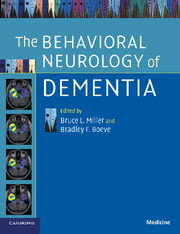Book contents
- Frontmatter
- Contents
- List of contributors
- Section 1 Introduction
- Section 2 Cognitive impairment, not demented
- Section 3 Slowly progressive dementias
- 18 Semantic dementia
- 19 Progressive non-fluent aphasia
- 20 Cognition in corticobasal degeneration and progressive supranuclear palsy
- 21 Cognitive and behavioral abnormalities of vascular dementia
- 22 CADASIL: a genetic model of arteriolar degeneration, white matter injury and dementia in later life
- Section 4 Rapidly progressive dementias
- Index
- References
21 - Cognitive and behavioral abnormalities of vascular dementia
Published online by Cambridge University Press: 31 July 2009
- Frontmatter
- Contents
- List of contributors
- Section 1 Introduction
- Section 2 Cognitive impairment, not demented
- Section 3 Slowly progressive dementias
- 18 Semantic dementia
- 19 Progressive non-fluent aphasia
- 20 Cognition in corticobasal degeneration and progressive supranuclear palsy
- 21 Cognitive and behavioral abnormalities of vascular dementia
- 22 CADASIL: a genetic model of arteriolar degeneration, white matter injury and dementia in later life
- Section 4 Rapidly progressive dementias
- Index
- References
Summary
Introduction
Vascular dementia (VaD) is a cognitive syndrome caused by cerebrovascular disease with clinically apparent ischemic or hemorrhagic lesions. It is not synonymous with post-stroke dementia, which refers to any type of dementia developed after a clinical stroke, irrespective of the presumed cause for the dementia (Pasquier et al.,1997). Unlike Alzheimer's disease (AD), which is accepted as the most common cause of dementia, reports on VaD show remarkably variable prevalence. Compared with western countries, the prevalence of VaD seems somewhat higher in eastern Asian countries such as China, South Korea and Japan, ranking second (Lee et al., 2002; Zhang et al., 2005; Dong et al., 2007) or even approaching the prevalence of AD (Yanagihara 2002). As the occurrence of stroke rises exponentially with age, the contribution of vascular disease to the incidence, pathogenesis and clinical course of dementia is becoming more important in the elderly. Also, the incidence of AD doubles in stroke patients, confounding understanding of the relative contribution of the two conditions to clinical status and treatment (Kokmen et al., 1996). Importantly, cognitive decline after stroke is common. In patients with a first stroke, fully one-fourth develop a newly diagnosed dementia within 1 year after the event (Andersen et al., 1996). Similarly, the relative risk of new onset of dementia is 5.5 within 4 years after first ever stroke (Tatemichi et al., 1994).
The clinical patterns of VaD differ, depending on the vessels involved (large versus small vessel), location of vascular lesions and the stages of disease.
- Type
- Chapter
- Information
- The Behavioral Neurology of Dementia , pp. 302 - 328Publisher: Cambridge University PressPrint publication year: 2009

